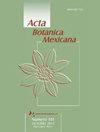A review of Acianthera subgenus Brenesia (Orchidaceae, Pleurothallidinae), with a new species from Mexico
IF 0.8
4区 生物学
Q4 PLANT SCIENCES
引用次数: 0
Abstract
Background and Aims: Brenesia was originally proposed to accommodate an odd taxon among the Orchidaceae subtribe Pleurothallidinae. This species is characterized by its sessile leaves, secondary stems covered by inflated sheaths and, especially, by a raceme produced at the base of the secondary stem. A few more closely related taxa were discovered afterwards, but the generic name has mostly been placed under the synonymy of Pleurothallis. Recent DNA-based studies showed that Brenesia constitutes a monophyletic group within the genus Acianthera. We present here a review of Acianthera subgenus Brenesia, delimiting each species in the group and providing a key for their identification. Methods: Specialized literature, specimens deposited in scientific collections, in cultivation, or available at online databases were reviewed. For each species, their known localities were georeferenced and displayed on a map of Mexico and Central America using QGIS software; also, their conservation status was assessed according to the IUCN Red List. Key results: Acianthera subg. Brenesia includes five species distributed from central Veracruz, Mexico, to Panama. The species included in this group are Acianthera costaricensis from Costa Rica and Panama; A. herrerae from Chiapas, in Mexico, and Guatemala; A. johnsonii from Chiapas to Honduras; and A. sotoana from (Mexico) Veracruz and Oaxaca. For each taxon, a morphological description, drawing, photo, information concerning nomenclature, distribution, habitat, phenology, and comparison with similar taxa are provided. Acianthera rzedowskiarum is described as a new species from Chiapas, based on specimens previously confused with A. johnsonii. Conclusions: Acianthera subgenus Brenesia has a distribution restricted to Central America. Four of its five species are native to Mexico, and one is restricted to southern Central America.标题蓝兰花亚属(兰科,薄藿香科)及墨西哥一新种综述
背景与目的:Brenesia最初是为了容纳兰科Pleurothallidinae亚部落中的一个奇怪的分类单元而提出的。本种的特点是其无梗叶,被膨胀的鞘覆盖的次生茎,特别是,在次生茎的基部产生的总状花序。后来发现了一些更密切相关的分类群,但其属名大多被置于Pleurothallis的同义词之下。最近基于dna的研究表明,Brenesia构成了一个单系类群,属于Acianthera属。在此,我们对亚种进行了综述,划分了亚种群中的每个种,并提供了鉴定的关键。方法:对专业文献、科学收藏、培养或在线数据库中的标本进行综述。对于每个物种,他们已知的位置是地理参考,并显示在墨西哥和中美洲的地图上,使用QGIS软件;并根据世界自然保护联盟红色名录对其保护状况进行了评估。【关键词】;Brenesia包括五个物种,分布在墨西哥韦拉克鲁斯中部到巴拿马。这一组的物种包括哥斯达黎加和巴拿马的Acianthera costaricensis;墨西哥恰帕斯州和危地马拉的A. herrerae;从恰帕斯到洪都拉斯的约翰氏杆菌;来自(墨西哥)韦拉克鲁斯州和瓦哈卡州的A. sotoana。对每个分类单元都提供了形态描述、绘图、照片、有关命名、分布、生境、物候以及与相似分类单元的比较等信息。acanthera rzedowskiarum被描述为来自恰帕斯州的新种,基于以前与a . johnsonii混淆的标本。结论:布雷尼西亚亚种仅分布于中美洲。它的五种中有四种原产于墨西哥,一种仅限于中美洲南部。
本文章由计算机程序翻译,如有差异,请以英文原文为准。
求助全文
约1分钟内获得全文
求助全文
来源期刊

Acta Botanica Mexicana
生物-植物科学
CiteScore
1.60
自引率
12.50%
发文量
52
审稿时长
>12 weeks
期刊介绍:
Acta Botanica Mexicana da a conocer trabajos originales e inéditos en todas las áreas de la botánica, incluyendo florística, taxonomía, taxones nuevos para la ciencia, ecología, etnobotánica, paleontología, evolución, conservación, etc. Está dirigida a botánicos mexicanos y extranjeros que aporten información en estas áreas del conocimiento, particularmente con plantas nativas del continente americano. Hasta 2018 apareció cuatro veces al año con una periodicidad estricta en la primera semana de enero, abril, julio y octubre; a partir de 2019 se publica de manera continua, sin periodicidad preestablecida, en formato electrónico y de forma gratuita.
 求助内容:
求助内容: 应助结果提醒方式:
应助结果提醒方式:


